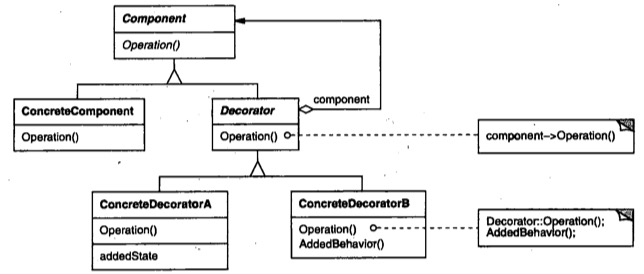初探装饰模式
代码链接
koonchen/design-patterns/decorator
要点
动态地给一个对象增加一些额外的职责。就增加功能来说, Decorator 模式相比生成子类更加灵活。
一个图形界面允许我们仅仅给某个窗口增加特性,比如窗口滚动。我们可以将窗口滚动的边框加入到一个组件中,这个对象被称为 装饰 。这个装饰与它所装饰的组件接口一致,因此它对使用该组件的客户透明。
假设现在有一个对象被称作 TextView ,它可以在窗口中显示正文,缺省的 TextView 没有滚动条,因为我们可能并不需要滚动条。当需要滚动条的时候,我们可以使用 ScrollDecorator 添加滚动条到 TextView 。如果我们还想在 TextView 周围增加一个粗黑边框,我们可以使用 BorderDecorator 添加滚动条。示意图如下:

从上文,我们可以发现, ScrollDecorator 和 BorderDecorator 类是 Decorator 类的子类。 Decorator 类是一个可视化组件的抽象类,具体结构如下:

VisualComponent 是一个描述可视对象的抽象类,它定义了绘制和事件处理的接口。 Decorator 的子类为特定功能增加一些操作。比如我现在想要一个滚动窗口,那么就可以使用 ScrollDecorator 对象的 ScrollTo 操作滚动这个界面,同时,我们不会感受到装饰和未装饰的差异。
在以下情况使用 Decorator 模式:
- 在不影响其他对象的情况下,以动态、透明的方式给单个对象增加职责;
- 处理那些可以撤销的职责;
- 当不能采用生成子类的方法进行扩充时。一种情况是,可能有大量独立地扩展,为支持每一种组合将产生大量的子类,使得子类数目呈爆炸性。另一种情况可能是因为类定义被隐藏,或类定义不能用于生成子类。
参与者以下:
- Component — 定义一个对象接口,可以给这些对象动态地增加职责。
- ConcreteComponent — 定义一个对象,可以给这个对象添加一些职责。
- Decorator — 维持一个指向 Component 对象的指针,并定义一个与 Component 接口一致地接口。
- ConcreteDecorator — 向组件添加职责。
总体结构如下:

decorator 模式的优点及缺点
- 比静态继承更灵活:与对象的静态继承相比, Decorator 模式提供了更加灵活的对象添加职责的方式。可以用添加和分离的方法,用装饰在运行时刻增加和删除职责。相比之下,继承机制要求为每个增加的职责创建一个新的子类,这会导致产生许多新的类,并且会增加系统复杂度。甚至可以对一个特定的 Component 类提供多个不同的 Decorator 类,这就使得你可以对一些职责进行混合和匹配。
- 避免在层级结构高层的类有太多的特征: Decorator 模式是一种即用即付的方法来添加职责。它并不试图在一个复杂的可定制的类中支持所有可预见的特征,相反,你可以定义一个简单的类,并且用 Decorator 类给他组件添加功能。
- Decorator 与它的 Component 不一样: Decorator 是一个透明的包装。如果我们从对象标识的观点出发,一个被装饰了的组件与这个组件是有差别的,因此,使用装饰时不应该依赖对象标识。
- 有许多小对象:采用 Decorator 模式进行系统设计往往会产生许多看上去类似的小对象,这些对象仅仅在他们相互连接的方式上有所不同,而不是它们的类或是它们的属性值有所不同。尽管对于那些了解这些系统的人来说,很容易对它们进行定制,但是很难学习这些系统,排错也很困难。
实现
在实现 Decorator 模式时有以下几点需要注意:
- 接口一致性:装饰对象的接口必须与它所装饰的 Component 的接口是一致的。
- 省略抽象的 Decorator 类:当仅需添加一个职责时,没有必要定义抽象 Decorator 类。
- 保持 Component 类的简单性:为了保证接口的一致性,组件和装饰必须公用一个父类,保持简单性很重要。
- 改变对象外壳与改变对象内核:可以将 Decorator 看做一个对象的外壳,他可以改变这个对象的行为。
java 实现
1 | class Component { |
对原始的 ConcreteComponent 增加了 addedState 和 addedBehavior 两个方法。
python 实现
1 | class Component(object): |
实现大同小异,不再赘述。
相关模式:
- Adapter 模式: Decorator 模式不同于 Adapter 模式,因为装饰仅仅改变对象的职责而不是改变接口;适配器模式给出了一个全新的接口。
- Composite 模式:可以将装饰视为一个退化的、仅有一个组件的组合模式。然而,装饰的目的是给对象增加职责,而不是将对象进行聚集。
- Strategy 模式:用一个装饰可以改变对象的外表;而 Strategy 模式使得我们可以改变对象的内核。这是改变对象的两种途径。